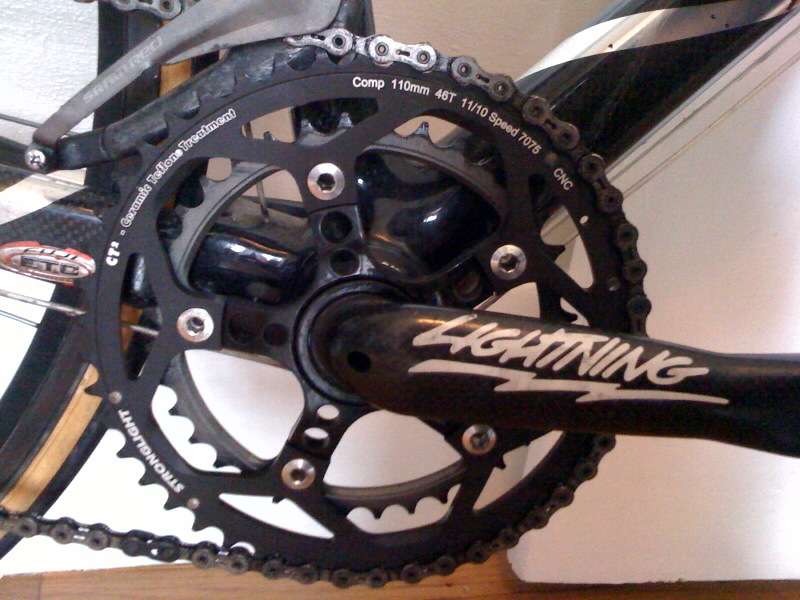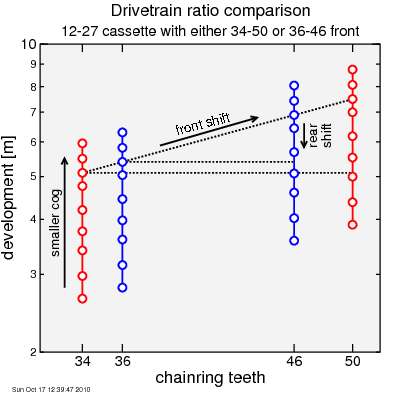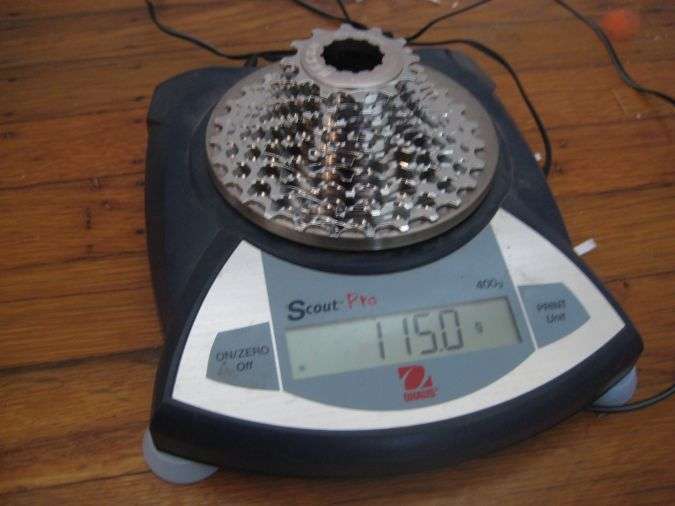36-46 drivetrain for Low-Key Hillclimbs
I just got a 46 tooth Stronglight CT² chainring from XXCycles. Very nice looking ring, teflon and ceramic coated for improved wear and, it is argued, lower friction.

I did make a mistake of not researching the mass, however: 92.9 grams versus 78.2 grams for a lower-end, uncoated 50 tooth Stronglight ring I'd previously purchased at Bike Nüt. Had I gone there for this one (I'd been busy and getting to the shop was impractical) I'd have likely caught the problem.
But while I'd hoped the smaller chainring would save mass, I didn't get the ring for mass alone (assuming one gram per tooth within a ring model, a decent approximation), and decided to use in in yesterday's Low-Key Hillclimb anyway. Why? Because the climb yesterday had an exceptionally non-uniform grade: there was going to be a lot of shifting, both front and back.

Typical compact (110 mm BCD) cranksets come with a 34-tooth inner and a 50-tooth outer chainring. In fact, the much-touted Zipp Vumaquad, which otherwise is an excellent chainring, is available only with either 34-50 or 39-53. The only alternate round rings are custom rings form small-scale producers like Fibre-Lyte, who make carbon fiber rings. Rotor and Q-Rings also make chainrings for the Vuma-Quad, but they're not round. In any case, the lack of chainring choice was sufficient reason for me to cross the Vuma Quad off my list of options when I was shopping for a crankset.
Despite the added mass, I was really glad I installed my 46-tooth ring for yesterday's climb. The following chart shows gear ratios (on the y-axis) plotted versus chainring (on the x-axis). The 36-46 combination is colored blue, while the 34-50 is colored red. In each case I'm using my new Recon 12-13-14-15-17-19-21-24-27 cassette, which I specifically got for steep climbs.

Consider the case where I am in my little ring and get down to the 14 cog. I want to shift up but I'm running out of room on the rear cassette, so it's time to move to the big ring. Focus only on the red points: assume I have a 34-50, the most common option with a compact crank. I shift from the 34 ring to the 50 ring. This has been a similar gear change as going from a 50-21 to a 50-14, a huge gear change. I likely didn't want to shift that far, so I need to then adjust by shifting the rear, for example three cogs down to a 50-19. So I shifted 34-14 to 50-14, then quickly 50-14 to 50-15, 50-16, 50-17, and 50-19. That's a lot of effort.
Now consider the alternate case: a 36-46. Here I shift from the 36-14 to 46-14. This is a similar ratio shift as going from 46-18 (not available on this cassette) to 46-14. I now can shift up to 46-16 or 46-17, probably the former as the latter is a fairly small change. So after shifting the front, i shift only once, maybe twice in the back, versus four times with the 34-50.
This all seems quite academic, but in the climb yesterday, it was a palpable difference. Instead of front-shifting into a gear which felt obviously overburdened, then click-click-click in the rear to get where I wanted to be, I front-shifted into a gear which was already in a reasonable cadence range, then maybe clicked the rear once to optimize.
But at what cost? Obviously the loss is at the top end, as a 46-12 isn't as big a gear as a 50-12. But the difference between a 46 front and a 50 front is similar, as is evident in the plot, as the difference between a 12 and 13 in the rear. So the 46-12 is like a 50-13. Pedaling this gear at 120 rpm, the top end of a cadence range beyond which sustainable power typically starts to drop, is a speed of 58 kph or 36 mph (assuming a 2.1 meter effective rolling circumference for the rear wheel). That's plenty fast for a time trial situation: about the only time I actively pedal faster than this is when I'm trying to hold a wheel on a sustained gradual descent. So there's really not much cost, certainly none for a hillclimb.

Recon 12-27 cassette
I actually enjoyed the days of 7-speed cassettes when you had to carefully select which cogs to use. With 10-speed cassettes these days, cog choice has become less critical. But there's still decisions to be made, still optimizations to be realized. Sure, I'm sure much of the advantage is psychological: the feeling I've out-clevered the competition who are now hopelessly burdened with their big chainring jump. But playing with the bike is part of the fun.

I did make a mistake of not researching the mass, however: 92.9 grams versus 78.2 grams for a lower-end, uncoated 50 tooth Stronglight ring I'd previously purchased at Bike Nüt. Had I gone there for this one (I'd been busy and getting to the shop was impractical) I'd have likely caught the problem.
But while I'd hoped the smaller chainring would save mass, I didn't get the ring for mass alone (assuming one gram per tooth within a ring model, a decent approximation), and decided to use in in yesterday's Low-Key Hillclimb anyway. Why? Because the climb yesterday had an exceptionally non-uniform grade: there was going to be a lot of shifting, both front and back.

Typical compact (110 mm BCD) cranksets come with a 34-tooth inner and a 50-tooth outer chainring. In fact, the much-touted Zipp Vumaquad, which otherwise is an excellent chainring, is available only with either 34-50 or 39-53. The only alternate round rings are custom rings form small-scale producers like Fibre-Lyte, who make carbon fiber rings. Rotor and Q-Rings also make chainrings for the Vuma-Quad, but they're not round. In any case, the lack of chainring choice was sufficient reason for me to cross the Vuma Quad off my list of options when I was shopping for a crankset.
Despite the added mass, I was really glad I installed my 46-tooth ring for yesterday's climb. The following chart shows gear ratios (on the y-axis) plotted versus chainring (on the x-axis). The 36-46 combination is colored blue, while the 34-50 is colored red. In each case I'm using my new Recon 12-13-14-15-17-19-21-24-27 cassette, which I specifically got for steep climbs.

Consider the case where I am in my little ring and get down to the 14 cog. I want to shift up but I'm running out of room on the rear cassette, so it's time to move to the big ring. Focus only on the red points: assume I have a 34-50, the most common option with a compact crank. I shift from the 34 ring to the 50 ring. This has been a similar gear change as going from a 50-21 to a 50-14, a huge gear change. I likely didn't want to shift that far, so I need to then adjust by shifting the rear, for example three cogs down to a 50-19. So I shifted 34-14 to 50-14, then quickly 50-14 to 50-15, 50-16, 50-17, and 50-19. That's a lot of effort.
Now consider the alternate case: a 36-46. Here I shift from the 36-14 to 46-14. This is a similar ratio shift as going from 46-18 (not available on this cassette) to 46-14. I now can shift up to 46-16 or 46-17, probably the former as the latter is a fairly small change. So after shifting the front, i shift only once, maybe twice in the back, versus four times with the 34-50.
This all seems quite academic, but in the climb yesterday, it was a palpable difference. Instead of front-shifting into a gear which felt obviously overburdened, then click-click-click in the rear to get where I wanted to be, I front-shifted into a gear which was already in a reasonable cadence range, then maybe clicked the rear once to optimize.
But at what cost? Obviously the loss is at the top end, as a 46-12 isn't as big a gear as a 50-12. But the difference between a 46 front and a 50 front is similar, as is evident in the plot, as the difference between a 12 and 13 in the rear. So the 46-12 is like a 50-13. Pedaling this gear at 120 rpm, the top end of a cadence range beyond which sustainable power typically starts to drop, is a speed of 58 kph or 36 mph (assuming a 2.1 meter effective rolling circumference for the rear wheel). That's plenty fast for a time trial situation: about the only time I actively pedal faster than this is when I'm trying to hold a wheel on a sustained gradual descent. So there's really not much cost, certainly none for a hillclimb.

Recon 12-27 cassette
I actually enjoyed the days of 7-speed cassettes when you had to carefully select which cogs to use. With 10-speed cassettes these days, cog choice has become less critical. But there's still decisions to be made, still optimizations to be realized. Sure, I'm sure much of the advantage is psychological: the feeling I've out-clevered the competition who are now hopelessly burdened with their big chainring jump. But playing with the bike is part of the fun.

Comments